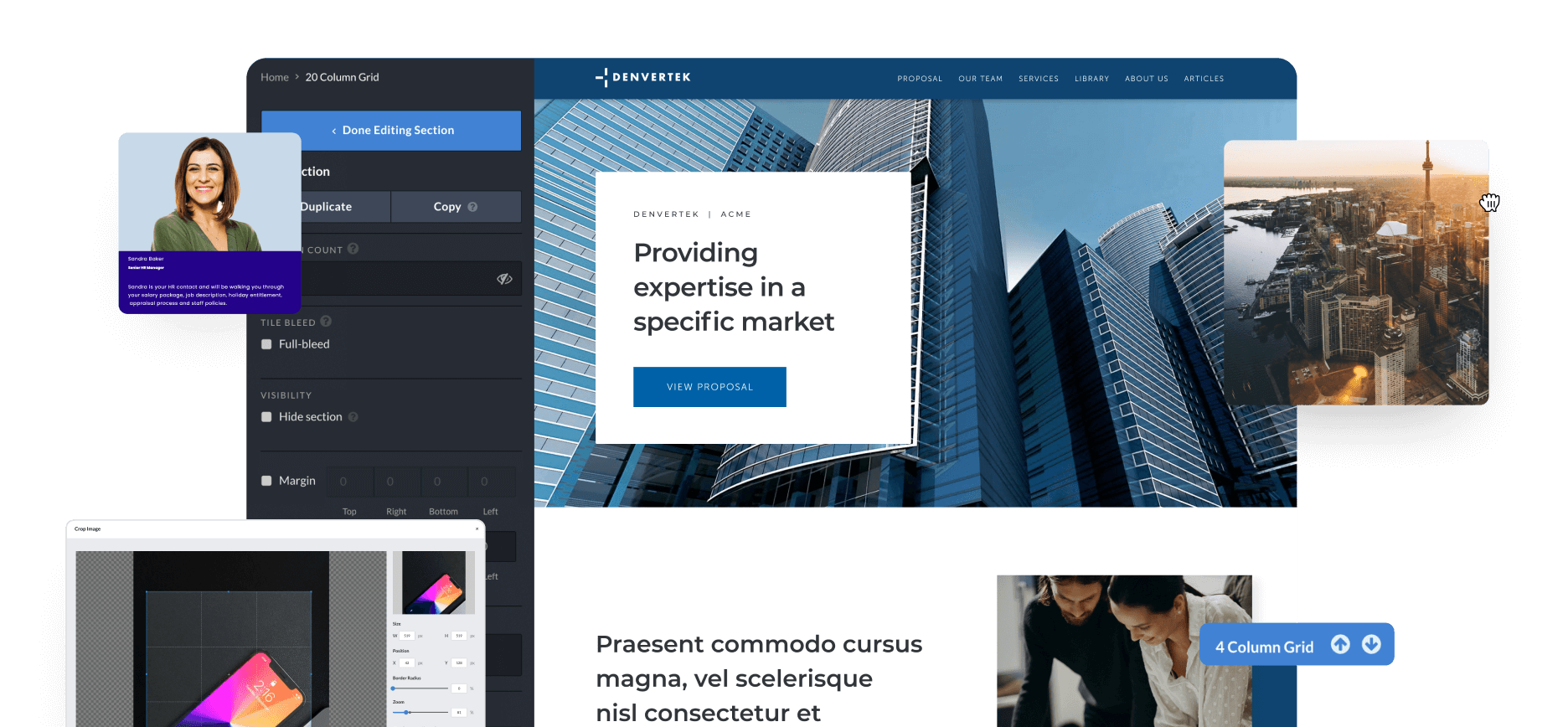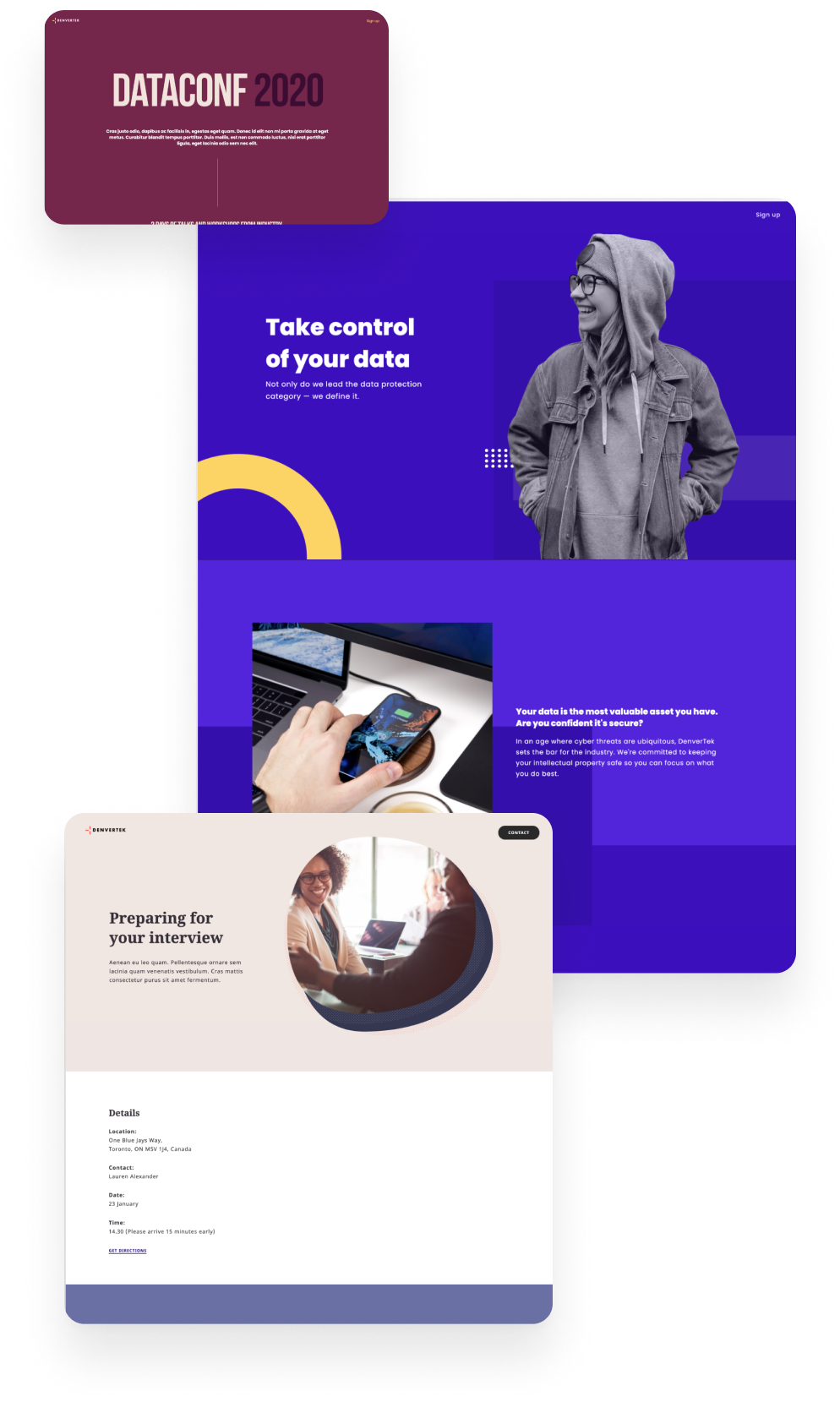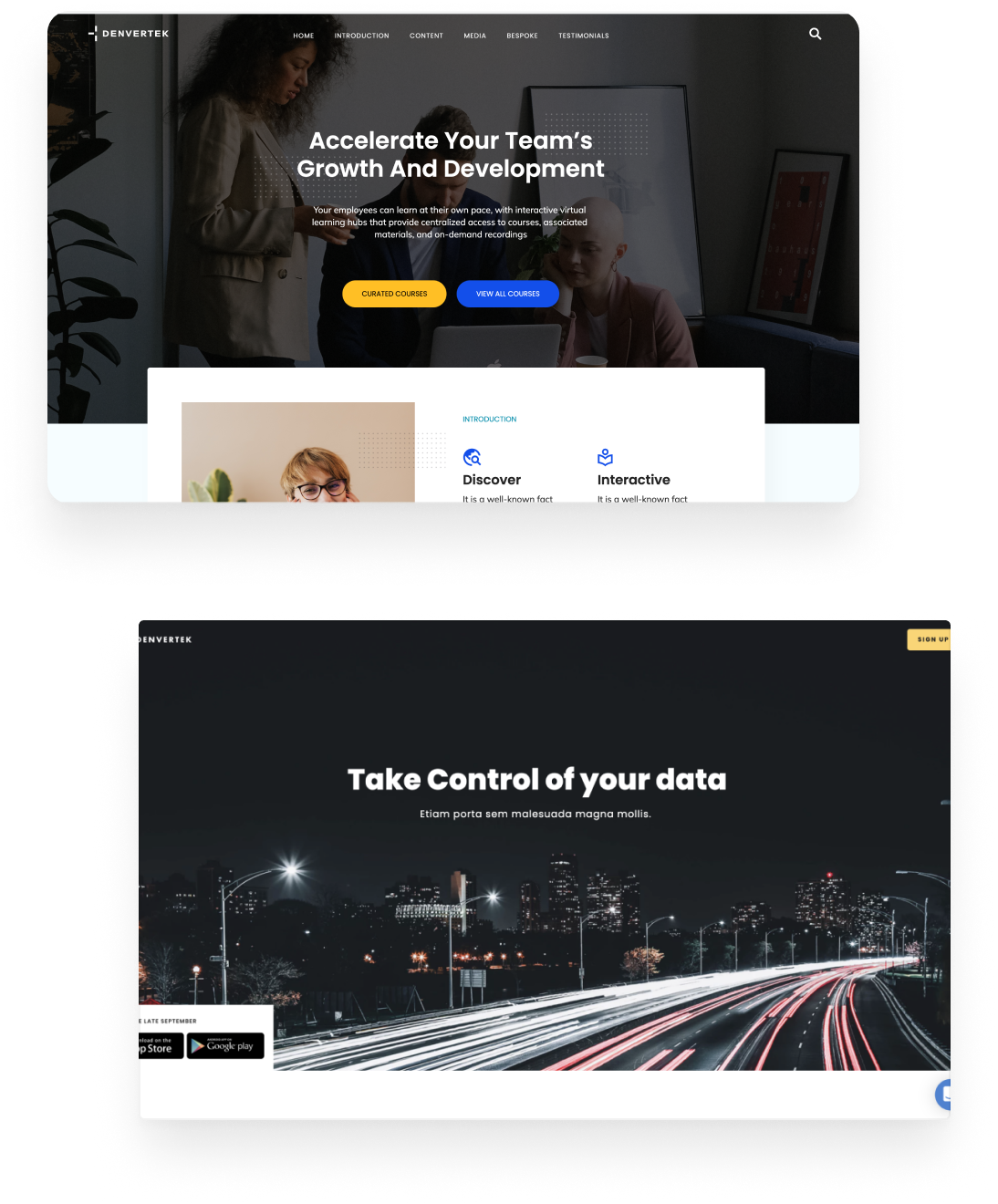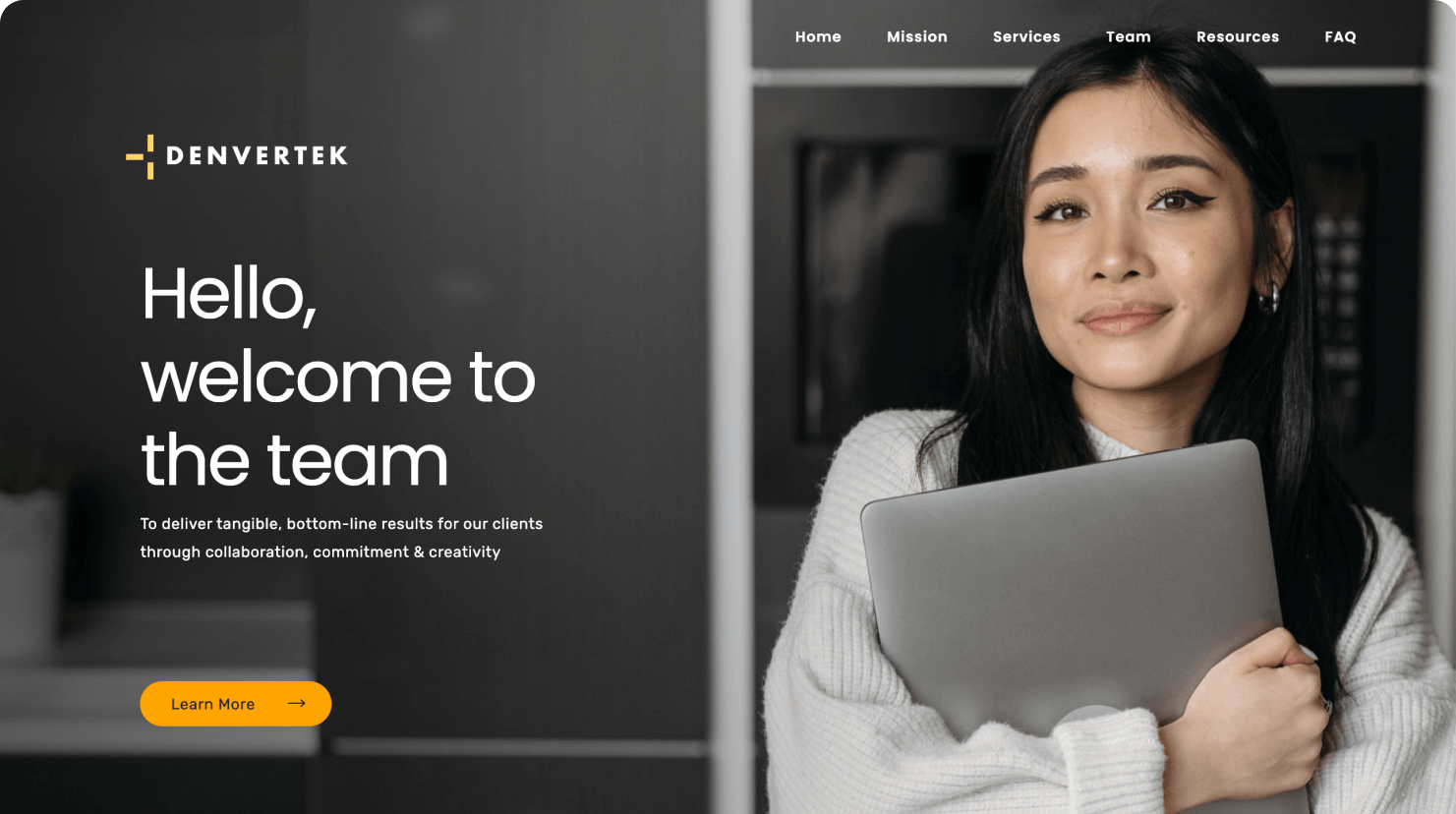Digital content experience platforms: why you need them and how to get started


Content experiences bring the power of integrated digital multimedia to your users. Among their many advantages are their ability to wow users with beautifully designed sites, present your message with more impact, and present all the key information in a single place.
But what are content experiences? Are they really any different from regular microsites? What are their advantages in relation to different use cases? Are they equally useful for a marketing team and a pursuits team at the same enterprise, for example? And how can you get started?
For answers to all these questions and more, read on.
First, let's imagine that the pursuits team at our imaginary enterprise has decided to be somewhat digitally forward and instead of sending a PDF sales proposal in response to an RFP have elected to deliver it in the form of a microsite.
That's a great start - microsites have a number of advantages over the traditional sales proposal which we'll get into in more detail later - but it doesn't necessarily follow that a microsite will be more engaging than a PDF.
In this first scenario, let's suppose that the microsite retains all the traditional elements of a sales proposal without integrating additional media elements.
While it's useful that it's a live document that can be updated to reflect changes and is more easily navigable, the experience for the reader is otherwise largely the same as it would have been reading a sales proposal form a printed page in the 1980s.
Indeed, it may be worse than a printed document in certain respects, because it represents a missed opportunity relative to a fully fleshed-out microsite-based content experience.
Because a more digitally forward and dynamic organization would opt for leveraging a product experience platform, and our hypothetical pursuits team have placed themselves at a potential disadvantage relative to other organizations in their market who do make the most of the selling potential of digital sales proposals.
What would a digital sales proposal in the form of a rich content experience look like, by contrast?
In our previous example, the core message was delivered purely by text. Any additional media was largely decorative - anyone unfamiliar with the content would be unable to interpret the content of each page without the main body of text.
With a content experience platform, this is not the case because it also doubles up as a user experience platform. Other forms of content such as images (which could take the form of graphs, infographics, charts, or diagrams), audio, video, and interactive elements also serve to convey the core message.
An example of the former approach in relation to images might be a photograph included on the page of a smiling executive shaking hands with a colleague in a stylish corporate office.
An example of the latter might be a flow diagram showing how a service offered by the bidders could transform or streamline core business processes within their HR and payroll teams.
The diagram could be supplemented with an embedded audio track of a member of the pursuits team explaining the value to the prospective client of this transformation, creating an integrated media experience in which the different elements of the page work together to communicate value, rather than relying purely on text to deliver the key message.
Because of this synergy between different elements, content experiences can be far more engaging to look at. Designers can use space that might otherwise have been taken up by long paragraphs of text in more creative ways that reflect the brand identity of their company:

This is the power of interactive content platforms. It's not that there's anything wrong with text. It's simply that by leaning on it too heavily in relation to other forms of media, the opportunity to take advantage of the potential of digital technology is missed. This is where microsite-based content experiences deliver.
At this point, you may be wondering if the terms 'content experience' and 'microsite' are synonymous.
Since some of the strongest content experiences are delivered in the form of microsites rather than being hosted as subpages of an organization's main URL, it's easy to see why the two might become conflated in the eyes of the casual observer.
However, it's important to distinguish between the concepts of microsite and content experience.
In business-to-business communications - particularly in sales - professionalism, security, and effective delivery of critical information is essential. And while there are a multitude of 'microsite builders' out there, not all of them have the features required by enterprises.
Simply put, the distinctions between full functioning content experience platforms and micosite builders go well beyond style and corporate branding.
Digital experience platform features need to be advanced enough to allow innovation and versatility. Ideally, a fully fledged content experience platform will have the following characteristics:
Drag-and-drop editing for non-specialists and easily customizable templates, allowing teams to deliver sites at speed and scale
No coding required to integrate the majority of media. For example, it should be as easy to add a video to a page as it is to insert a block of text
Brand compliance baked in. While many microsite builders do not have specific solutions to ensure pages meet brand guidelines, a fully functional content experience platform will have a feature allowing templates to be fixed according to those guidelines
Support for custom CSS editing, allowing designers and web developers to create microsites in line with what the business needs, rather than what a mass-market site builder is willing to cater to in a one-size-fits-all editor
Detailed visitor analytics, allowing the microsite owner to get an overview of how users are interacting with the site and iterate their messaging and interaction with prospects based upon real data rather than guesswork
Advanced security features and visitor access restrictions, ensuring that only people who are meant to see sensitive information do so
These are the main features of experience-centric content platforms that go above and beyond what a generic microsite might offer in addition to their greater usage of a wider range of media.
To summarize, content experiences on an all in one digital content platform go beyond standard microsites by including a broader set of front and backend features more suitable for the world of business-to-business communications.
The Coronavirus crisis pulled considerable attention to the advantages that accrue to businesses that are able to conduct a greater range of their activities remotely as well as many of the challenges for those struggling to adapt.
While the most commonly cited examples of businesses that traditionally raise revenue from in-person, human-to-human interaction and have therefore struggled during the COVID-19 crisis are business-to-customer (B2C) companies such as airlines, bars, restaurants, cinemas, and tourist attractions, what's less often appreciated are the challenges the situation has imposed on business-to-business (B2B) activity.

As many in the world of B2B sales and pursuits will be aware, while the initial stages of a bidding process (such as the issuing of a request for proposal, or RFP, and the first responses from those sending sales proposals) are regularly conducted remotely, the crucial stages of the sales cycle are frequently carried out in-person.
The notion that a face-to-face presentation followed by a handshake will 'seal the deal' has been an established B2B sales practice since the emergence of large scale corporate activity in the nineteenth century.
Why?
Quality sales practice is built upon the foundation of relationship building. An in-person meeting allows for greater depth of interpersonal interaction, helping to cement trust and humanize sales professionals in the eyes of prospective customers.
This is one reason why securing an in-person meeting is such a priority for salespeople in a range of industries.
The Covid-created inability to meet in person due to the reasonable restrictions placed upon travel and meeting in groups outside of single households combined with the real need to socially distance presented a challenge to those companies whose sales philosophy emphasized real-world meetings. This is where the adoption of a digital content platform or a product experience platform can play a significant role.
Many of those companies had to play catch-up, as not every organization is in a similar position.
The Coronavirus crisis has decisively shifted the balance between those companies prepared to fully utilize digital technology in their communications and outreach strategies and those over reliant on face-to-face meetings in favor of the former, digitally forward group.
Earlier, “human touch” could only be achieved when interpersonal interactions took place face to face. However, with modern-day interactive content tools, it has become possible for a business to forge an emotional connection with its audience even in digital settings. This is why organizations with interactive content tools enjoy a considerable advantage over their less technologically-focused counterparts when it comes to delivering emotionally engaging content.
At Zoomforth, we have direct experience of this phenomenon as our clients have been able to utilize our digital content experience platform to build relationships with current and potential future clients:
Read Case Study
However, it would be all too easy to assume that the need for organizations of all kinds - but particularly enterprises - to shift towards technologies that can put remote communication on par with in-person meetings is only a short -term trend resulting from Covid.
Indeed, the history of the last hundred and fifty years in business has arguably been one of a growing capacity to interact and carry out transactions remotely.
Just as the telephone allowed for significantly more 'human' interactions than the electrical telegraph, the growth in popularity of Zoom, Google Hangouts, Skype, or Facetime video calls has added another layer of humanity to remote business communication.
Humans are used to communicating on multiple levels simultaneously and find it 'more direct' to do so. By observing the facial expressions of a conversational partner, we gain a fuller understanding of their meaning than we might have done with the same number of words alone.
This human capacity to absorb, digest, and attribute meaning to multiple types of input simultaneously is one of the reasons branding and design is so important to modern businesses.
As an example, consider the Nike brand identity. The slogan 'Just do it.' on its own conveys relatively little of character of the company. It is with the addition of the signature swoosh, the bold lettering, and the images of urban culture and settings that its full meaning is communicated.
In short, good branding combines multiple elements and conceptually distinct forms of media to build a relationship with its audience.The same is true of web design and online communication more generally.
Content experience platforms are useful assets to remote communicators such as pursuits teams because of their ability to combine different forms of multimedia in highly textured landing pages and microsites in a way that speaks to the human desire to communicate on multiple levels.
In this sense, they improve upon websites or documents that lean too heavily on purely text-based communication.


With the many parallels between sales and marketing, it's perhaps unsurprising that many of the advantages of content experiences that apply in the case of sales and pursuits can also be found in digital marketing.
At a time when the preference for online content among the young, particularly Generation Z, for richer online content such as video has been widely established, content experiences are a clear way to make the most of this opportunity.
89% of Gen Zers use YouTube on a weekly basis
The ManifestBut that doesn't mean that target markets of all generations can't be better served by marketing that utilizes more diverse content formats. According to LinkedIn, only 50% of B2B brands produce content that their audience actually engages with, and a content experience platform with an integrated video feature can help with this whatever the demographic:
An interactive content platform incorporating video can therefore help marketers speak to consumers in a way they prefer.
Content experiences can help you show your company in its best light with a rich diversity of content that gives your candidates a window on both your company and the recruitment process, potentially meaning smoother hiring processes from the initial application right through to onboarding.
Content experience platforms bring value to recruitment teams in five key areas:
It's hard to fully convey the story of your brand through a job description. An enriched microsite goes further toward showing candidates who you are, with highly engaging content experiences. Why tell them about your snazzy headquarters when you can show them? Why not have their potential future colleagues explain your terrific company culture in video?
During multistage hiring processes, making sure the right person gets the right information at the right time can be a challenge. With Zoomforth, you can link to your content experiences from any platform or candidate touchpoint. And all your microsites can be protected with security features like multi-factor authentication, single-sign on ID, and of course, password protection.
As we saw in the marketing section above, the Gen Zers and Millennials are more receptive to video communication. This extends to their professional lives as candidates for roles at your company. Attracting top talent is competitive. Get a leg up.
WYSIWYG (what you see is what you get) editing with drag-and-drop features means no more waiting on overburdened design teams. A microsite platform like Zoomforth can save time and money. This is particularly useful in recruitment, where delivering compelling content at scale can be a real differentiator.
If you're wondering whether a candidate you've sent an offer to is seriously considering accepting, it might be helpful to know if they've viewed your digital offer letter recently, or your explanation of the responsibilities of the position. A content experience platform like Zoomforth can give you these kinds of insights down to a level of detail that can give you truly actionable information. For example, has the candidate viewed the section of your microsite that tells them how to take the next steps? If not, maybe a follow-up is in order.

Ensuring proper remote training is more important than ever. The modern enterprise demands modern learning experiences that are up to the task.
By using a content experience platform like Zoomforth, employees can learn at their own pace, with interactive virtual learning hubs that provide centralized access to courses, associated materials, and on-demand recordings.
According to research by Rapt Media, 86% of employees learn better from visual content like video rather than text.
Microsite-based learning environments help students and teachers alike by:
These plans document a change in approach that’s normally the result of a shift in one of three areas:
Business transformation plans are useful because they make the case for the change and lay out the specifics in clear steps that are accessible by all relevant stakeholders, helping to reduce confusion, get everyone on the same page, make sure everyone knows what they’ve agreed to, and give people a reference point for judging the success of the project.
If you’re considering introducing a content experience platform into your organization - particularly a major enterprise - a business transformation plan is a good place to start.
Now you have an idea of the value of content experience platforms as well as of the preliminaries of getting started with them, this is a great opportunity to discuss these ideas with a member of your team or reach out to us with any questions you may have at Zoomforth.com.